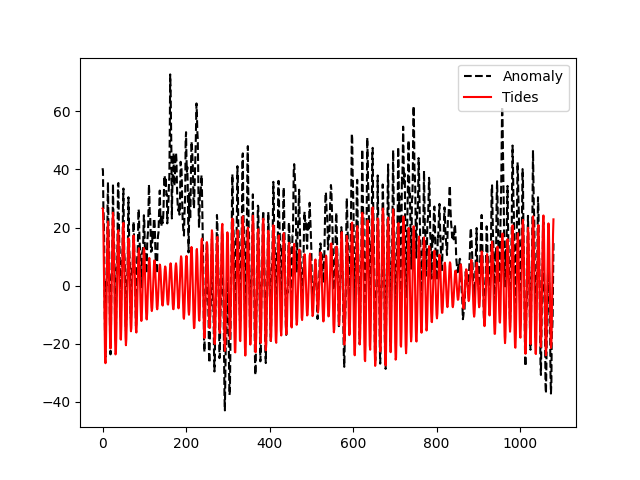Tides and the sea level - Part 2¶
Two weeks ago we calculated the sea level elevation in Stavanger related to tidal motions given the amplitudes, periods and phases of 6 components. We are getting back to that example again, but now we will take a look at some observed data.
Task 1: First things first, we read from the dataset
stavanger.txt. For this, we use the function read_csv from
Pandas:
import pandas as pd
df = pd.read_csv('stavanger.txt', sep=r"\s+")
df.keys()
This gives us the following output:
Index(['time', 'ssh', 'anomaly', 'M2', 'S2', 'N2', 'K2', 'O1', 'K1', 'tide'], dtype='object')
The df Dataframe contains hourly dates between 09/2018 and 09/2019 of the
observed sea surface height (cm) in Stavanger, its anomaly (ssh - mean) and the
tidal elevations (of each component and their summation) that we calculated
previously.
Task 2: To proceed with the comparison between the tidal components
and the observed sea surface height, let’s select the first 45 days of
the df dataset.
Tip: use the function iloc from Pandas.
import numpy as np
t = np.arange(0, 45*24+1, 1) # 45 days
df_sm = df.iloc[0:len(t)]
df_sm
We get the following output:
| time | ssh | anomaly | M2 | S2 | N2 | K2 | O1 | K1 | tide | |
|---|---|---|---|---|---|---|---|---|---|---|
| 2018-09-13 | 00:00:00 | 106.2 | 40.428946 | 14.966470 | 6.650923 | 1.380173 | 1.128245 | 1.367263 | 1.099229 | 26.592303 |
| 2018-09-13 | 01:00:00 | 105.3 | 39.528946 | 15.634982 | 5.426019 | 2.258865 | 1.173072 | 1.174997 | 0.745735 | 26.413670 |
| 2018-09-13 | 02:00:00 | 92.5 | 26.728946 | 12.386691 | 2.747218 | 2.592491 | 0.902034 | 0.913493 | 0.341124 | 19.883051 |
| 2018-09-13 | 03:00:00 | 88.4 | 22.628946 | 6.035344 | -0.667698 | 2.300545 | 0.388111 | 0.598161 | -0.086869 | 8.567594 |
| 2018-09-13 | 04:00:00 | 79.9 | 14.128946 | -1.827951 | -3.903705 | 1.453475 | -0.230316 | 0.247583 | -0.508908 | -4.769821 |
| ... | ... | ... | ... | ... | ... | ... | ... | ... | ... | ... |
| 2018-10-27 | 20:00:00 | 49.2 | -16.571054 | -13.860386 | -2.747218 | 1.269579 | 0.628035 | -0.076464 | 1.341275 | -13.445178 |
| 2018-10-27 | 21:00:00 | 50.4 | -15.371054 | -8.388605 | 0.667698 | 2.192932 | 1.052723 | 0.288132 | 1.050467 | -3.136652 |
| 2018-10-27 | 22:00:00 | 54.5 | -11.271054 | -0.815350 | 3.903705 | 2.587127 | 1.193952 | 0.635750 | 0.687655 | 8.192839 |
| 2018-10-27 | 23:00:00 | 66.2 | 0.428946 | 6.962163 | 6.093717 | 2.357046 | 1.013693 | 0.945905 | 0.277707 | 17.650232 |
| 2018-10-28 | 00:00:00 | 80.4 | 14.628946 | 12.995547 | 6.650923 | 1.558206 | 0.560485 | 1.200323 | -0.151276 | 22.814208 |
1081 rows × 10 columns
Task 3: Let’s visualize how things look like. Plot the anomaly and tide variables.
import matplotlib.pyplot as plt
plt.plot(df_sm.anomaly.values, 'k--', label='Anomaly');
plt.plot(df_sm.tide.values, 'r-', label='Tides');
plt.legend(loc='upper right')
plt.show()
We get the following plot:

Very good! As expected (why?), the observed sea surface height is not equal to the pure tide signal, but if you zoom in at the peaks (or throughs), you will see that they are in phase and this is an indicator that we are on the right track.
Question: How much of the observed signal is composed by tides?
To answer this, we will estimate the energy (J) contained in both signals by using the following equation:
where N is the number of points of your signal (length) and F(t) is your time series.
Task 4: Given the previous equation, we calculate the energy of the
anomaly and tide signals and the ratio between them. We implement the
function energy that takes as arguments both signals and returns the
\(\frac{E_{tide}}{E_{anomaly}}\) ratio as percentage.
def energy(anomaly, tide):
e_anom = ((abs(anomaly))**2)
e_tide = ((abs(tide))**2)
# plot energies
plt.plot(e_anom, 'k', e_tide,'r')
ratio = np.sum(e_tide) / np.sum(e_anom) # calculate the ratio between the energies
return ratio*100 # in percentage
# calculate the ratio
ratio = energy(df_sm.anomaly.values, df_sm.tide.values)
plt.show()
print('The ratio is: %f%%\n'%(ratio))
We get the following output:
The ratio is: 32.158691%
and the following plot:

As any other wave, tides also travel (propagate) in the ocean. Their phase velocity is given by:
where g is the acceleration of gravity and D is the ocean depth.
Task 5: Considering g = 10 m s\(^{-2}\) and D = 4000 m, how fast (in m s\(^{-1}\)) does this wave travel?
How much time (in hours) does it take to travel from Stavanger to Bodø? Consider the distance between the two cities as 1200 km.
g = 10 # gravity
D = 4000 # water depth
L = 1200 # distance, in meters
c = (g*D)**0.5
print('The phase velocity is %f m/s'%(c))
dt = L/(c*3.6)
print('The phase velocity is %f hours'%(dt))
We get the following output:
The phase velocity is 200.000000 m/s
The phase velocity is 1.666667 hours
This is impressively fast, right? Putting these numbers in words, a tidal crest observed in Stavanger is also observed in Bodø, 1200 km away, a bit more than one and a half hours later!